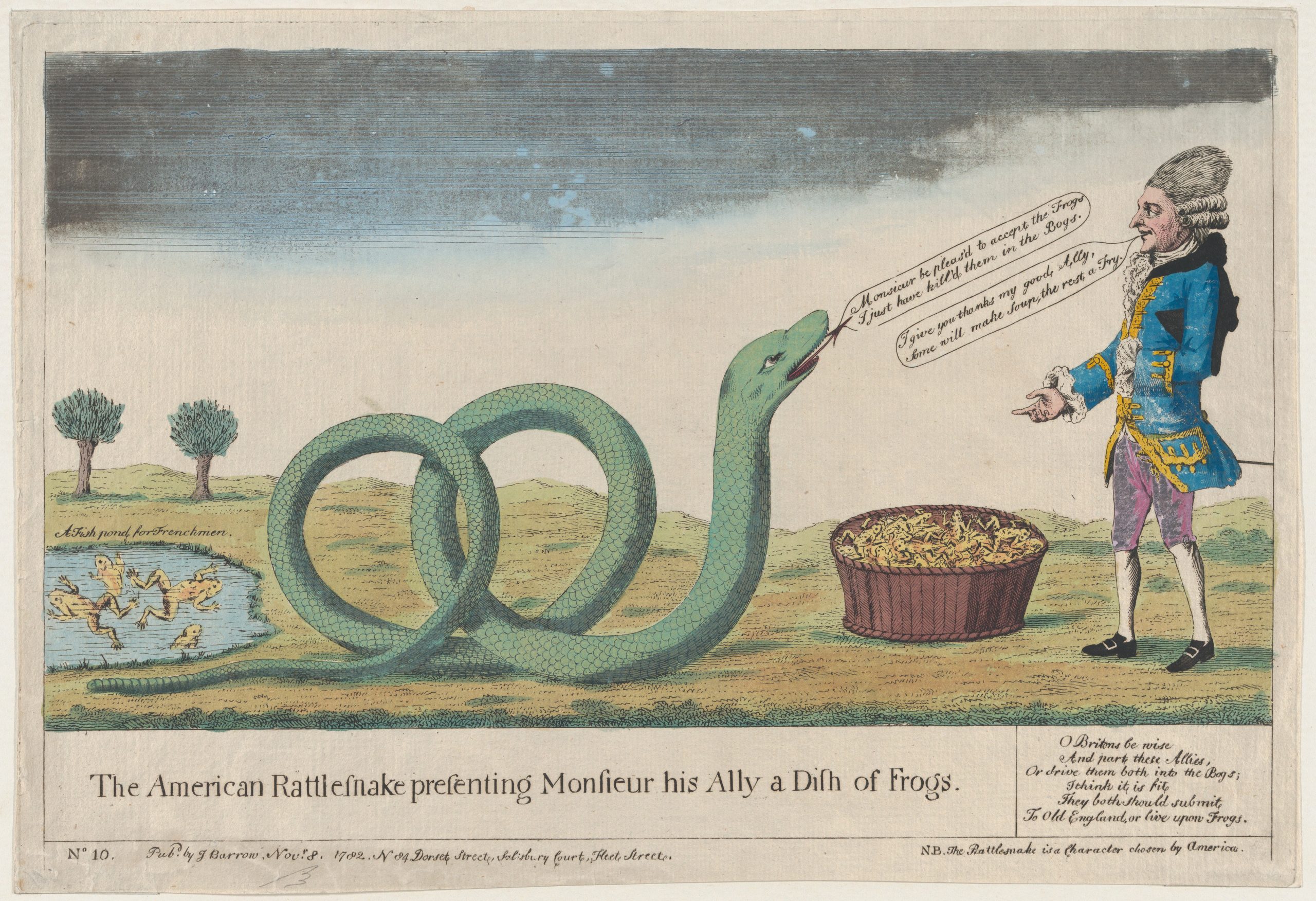Prints created during the Revolutionary War by American, British, French and other Continental printmakers offer unique insights on how contemporaries—artists, engravers and their audiences—viewed the people, events and ideas of the American Revolution. The ten Revolutionary War prints featured here—portraits, satirical prints, scenes of battle and other events, and elaborate allegories—represent the genres that attracted printmakers and their audiences. They also represent the variety of methods employed by printmakers, from simple copperplate engravings to mezzotints, etchings and composite prints involving more than one printmaking technique.
European artists raised printmaking to the peak of sophistication in the seventeenth and eighteenth centuries. By the middle of the eighteenth century, prints had become an important medium for disseminating visual information, both as illustrations in books and pamphlets, and as separately published works sold by print shops and collected by a growing number of consumers for whom fine prints were a sign of refined taste as well as their engagement with public affairs. Specialty print shops in European cities served this consumer market, exhibiting new prints in elaborate displays designed to attract connoisseurs and casual buyers for whom the latest prints were prized ornaments to the well-appointed home.
American printmaking lagged far behind European printmaking during the eighteenth century, but the American Revolution created a market for printed portraits of American leaders and depictions of events in America that could not be supplied by European printmakers, who created imaginary and often ludicrously inaccurate representations of people, places and events in America. European portraits of American leaders were mostly fanciful, and European printmakers littered Revolutionary America with palm trees, depicted Boston, New York and Philadelphia like European cities, and illustrated Revolutionary War battles as if they were fought on open plains by armies using linear tactics. American prints are crude by comparison, but what they lack in sophistication they make up for in immediacy and far greater accuracy. Amos Doolittle, Bernard Romans and Joseph Hiller may have been amateurish printmakers, but they depicted scenes and events they witnessed or at least understood. Charles Willson Peale may have been a self-taught engraver, but his engraved portrait of George Washington was based on his own painted life portraits of the commander-in-chief. The market for prints in America was small and poorly developed during the American Revolution. American printmakers consequently published their work in small editions, making examples of their work much rarer than most contemporary European prints.
All of the prints featured here were published during the Revolutionary War and sold as single sheets rather than as illustrations in books or pamphlets. They were all intended for display, either framed or in a collection of prints stored in a portfolio or cabinet. Prints included as illustrations in books and pamphlets were mostly woodcuts and wood engravings—relief printing techniques compatible with typesetting. Intaglio prints appeared in more expensive books, but they had to be printed separately and then bound with the typeset pages or, as was sometimes done with folding plates, glued into the typeset pages. Engraved frontispieces were the most common intaglio prints in eighteenth-century books. With few exceptions, they were small prints, unlike the ones featured here.
The First PuBlished image of a Revolutionary War Battle
Ralph Earl, artist, and Amos Doolittle, engraver
The Battle of Lexington
[New Haven, Connecticut: Amos Doolittle, 1775]
Connecticut Historical Society
The first print of the Battle of Lexington was created by two young militiamen, Ralph Earl and Amos Doolittle. Neither witnessed the battle, but they visited the site a few weeks later, spoke with participants and created a sketch of the battle. Earl, who later became an accomplished artist, created the image. Doolittle, a Connecticut silversmith, engraved the image on a copper plate and sold the prints beginning in December 1775. The print of the Battle of Lexington was one of four scenes of the war’s first day Doolittle engraved and sold. The others depicted the British marching into Concord, the Battle of Concord, and the running battle of the afternoon as the British troops withdrew to Boston. Despite their primitive quality, they are the most important prints of the Revolutionary War.
The militiamen in the print of the Battle of Lexington don’t look very organized and aren’t particularly heroic. None of the Americans are depicted returning fire. A few are looking toward the British but most are fleeing, leaving the Lexington Green scattered with dead and wounded men. Earl and Doolittle chose this moment because they wanted to depict the Lexington militiamen as victims of British tyranny—drawn up on the Lexington Green only to be shot down by British soldiers. Except for some entirely fanciful depictions, Earl and Doolittle’s image of the events on Lexington Green remained the dominant image of the battle for more than fifty years. It was reproduced many times in a variety of prints, but the important aspects of the image varied little.
Read about the influence of this print
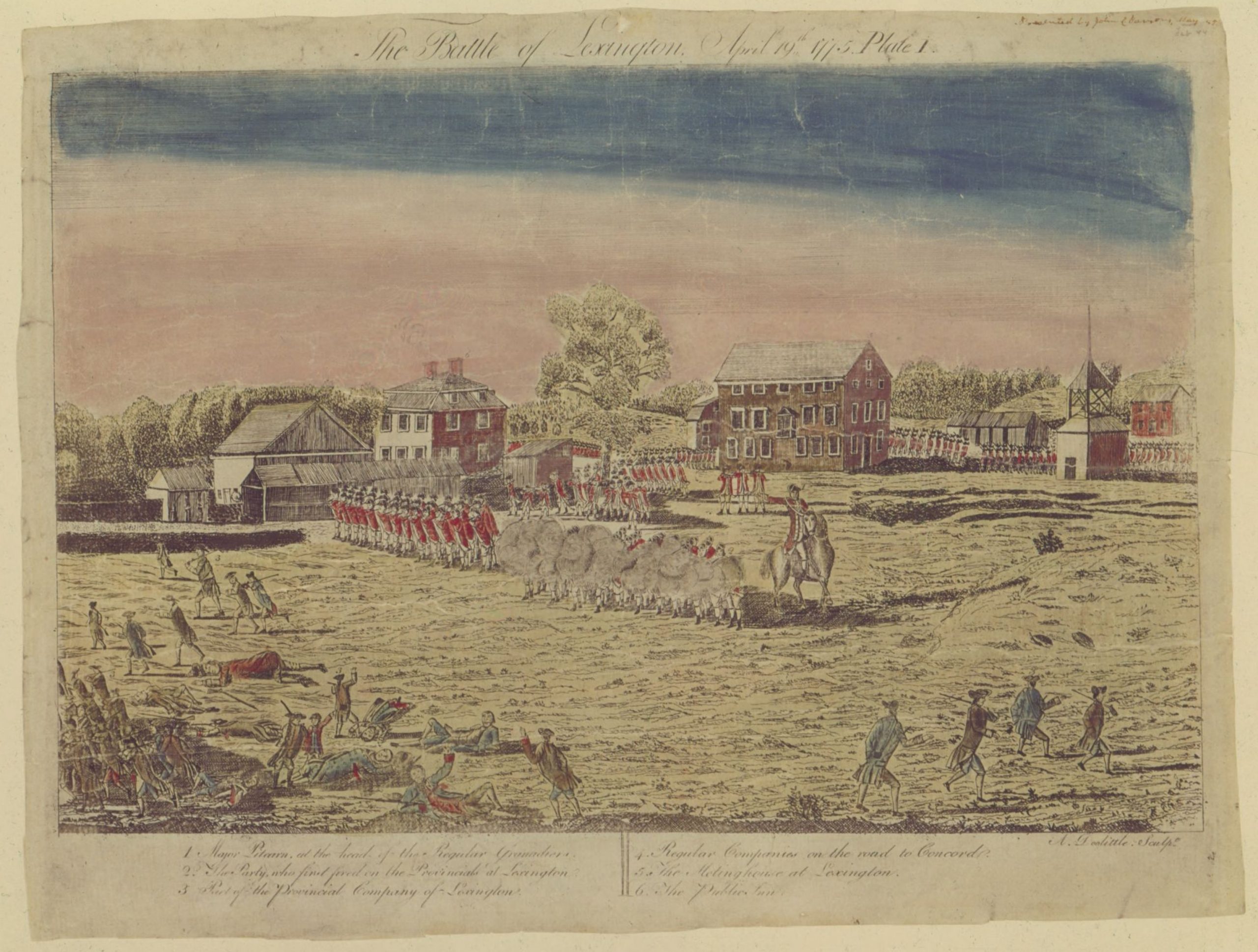
The First Published Image of the Battle of Bunker Hill
Bernard Romans, artist and engraver
An Exact View of the Late Battle at Charlestown
[Philadelphia: Printed for Bernard Romans, 1775]
William L. Clements Library, University of Michigan
The first published image of the Battle of Bunker Hill was created by Bernard Romans, a surveyor and cartographer who was outside Boston when the battle took place. Romans drew a sketch of the battle based on his knowledge of the setting and descriptions of participants. He traveled to Philadelphia that summer and placed an advertisement in the Pennsylvania Gazette on September 20, 1775: “It is proposed to print an exact view of the late Battle at Charlestown, June 17, 1775 . . . on good crown imperial paper, to be delivered to the subscribers in about ten days: The price to the subscribers is 5s. plain, and if colored 7s.” Before the print was ready to sell, a Philadelphia printer named Robert Aitken obtained one of the prints, copied it—without any credit to Romans—and offered it for sale. In an advertisement published in the Pennsylvania Ledger on October 7, the frustrated Romans described his view as “much superior to any pirated copy now offered or offering to the public.” But it was too late. Aitken’s cheaper pirated version had saturated the market.
Romans’ depiction is primitive, but richly detailed. On the right and in the middle foreground, British warships fire in support of a British assault. Charlestown, at right center, is in flames, as it was after Admiral Sir Richard Howe ordered his warships to fire heated shot into the town, which was reduced to ashes. The British army is advancing in lines, as it did during the disastrous first and second assaults. This tactic was adopted to overawe the rebels and reflected British contempt for their opponents. Only on the third assault did the British resort to the more conventional tactic of advancing rapidly in columns. Look closely, and you will see that the left flank of the British attack is crumbling under American fire, and redcoats are retreating, leaving their wounded on the field. British artillery can be seen, very faintly, between the British infantry and Charlestown. British guns, which should have advanced with the infantry, were supplied with the wrong ammunition and did not advance in support of the infantry until the third assault, after the right ammunition arrived.
Learn more about images of Bunker Hill
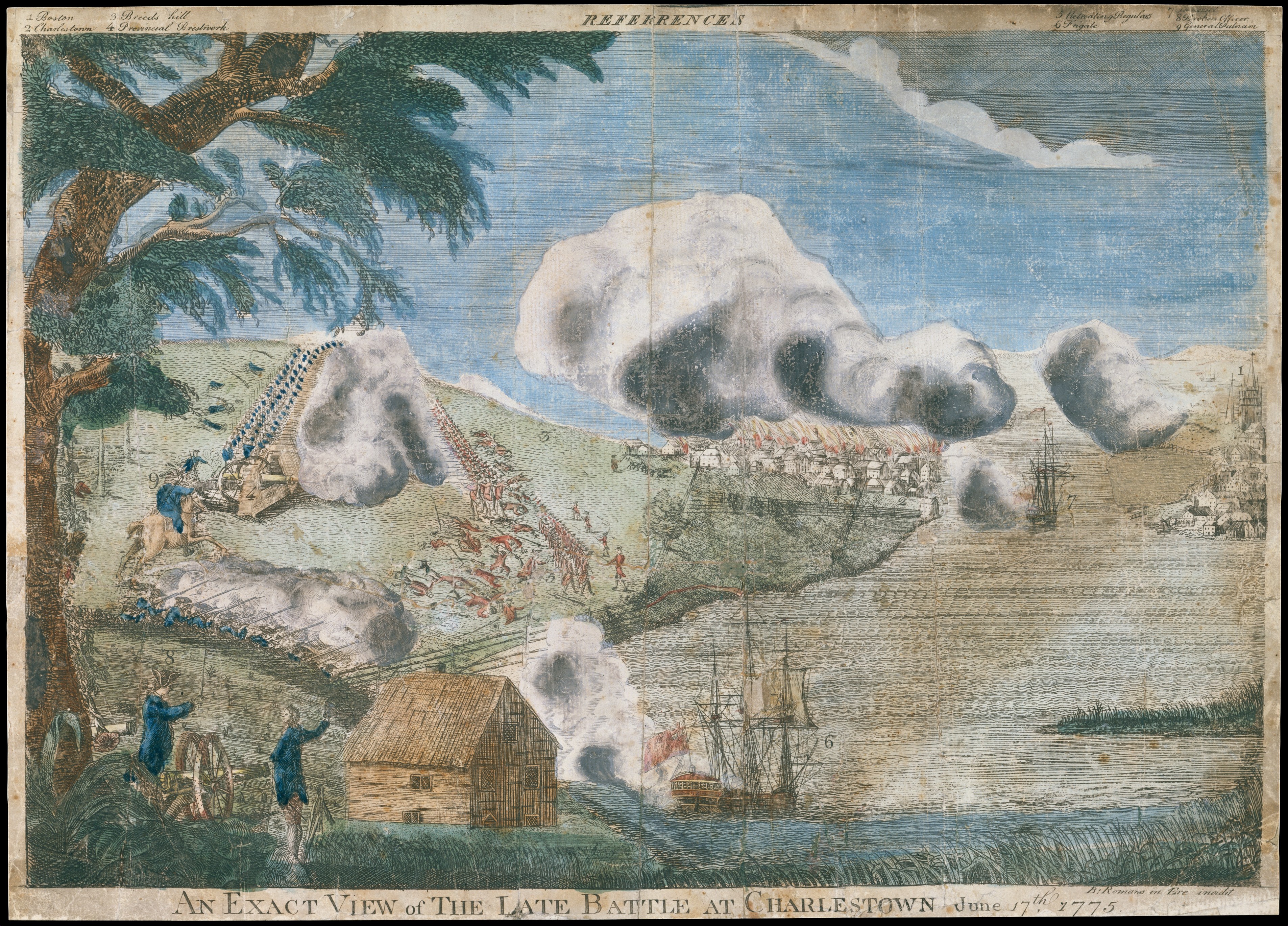
A British Satire on the Plight of British Soldiers
Attributed to James Gillray, artist and engraver
Six-Pence a Day
London: W. Humphrey, October 26, 1775
The American Revolution Institute of the Society of the Cincinnati
British soldiers led a hard life with little hope of reward, as this satirical print from the first months of the war makes clear. At the center is an emaciated grenadier, his toes poking through his worn-out shoes. His pregnant wife and children are crying out for his help. At his feet is inscribed “The Target,” and two American soldiers, with “Death or Liberty” on their caps, are firing at him. “Famine” awaits him at far right. The figures at left represent three of the most poorly paid trades in Britain—a chairman, a coachman holding a foaming mug of beer (with the publisher’s initials on it) and a ragged little chimney sweep—all better off than the soldier. Their daily pay is in the legend below: “3 Shillings a Day, 2 Shillings a Day, 1 Shilling a Day” while the soldier earns “Six-Pence a Day.”
This is an etching, made by coating a copper plate with “ground”—an acid-resistant coating, often a wax—and then using a thin, needle-like tool to cut fine lines in the ground to create the image. The plate was then submerged in an acid bath, which removed minute amounts of copper where the ground had been cut, incising the design into the plate. This etching is almost certainly an early work of James Gillray, who became the leading British satirical artist of the 1780s and 1790s.
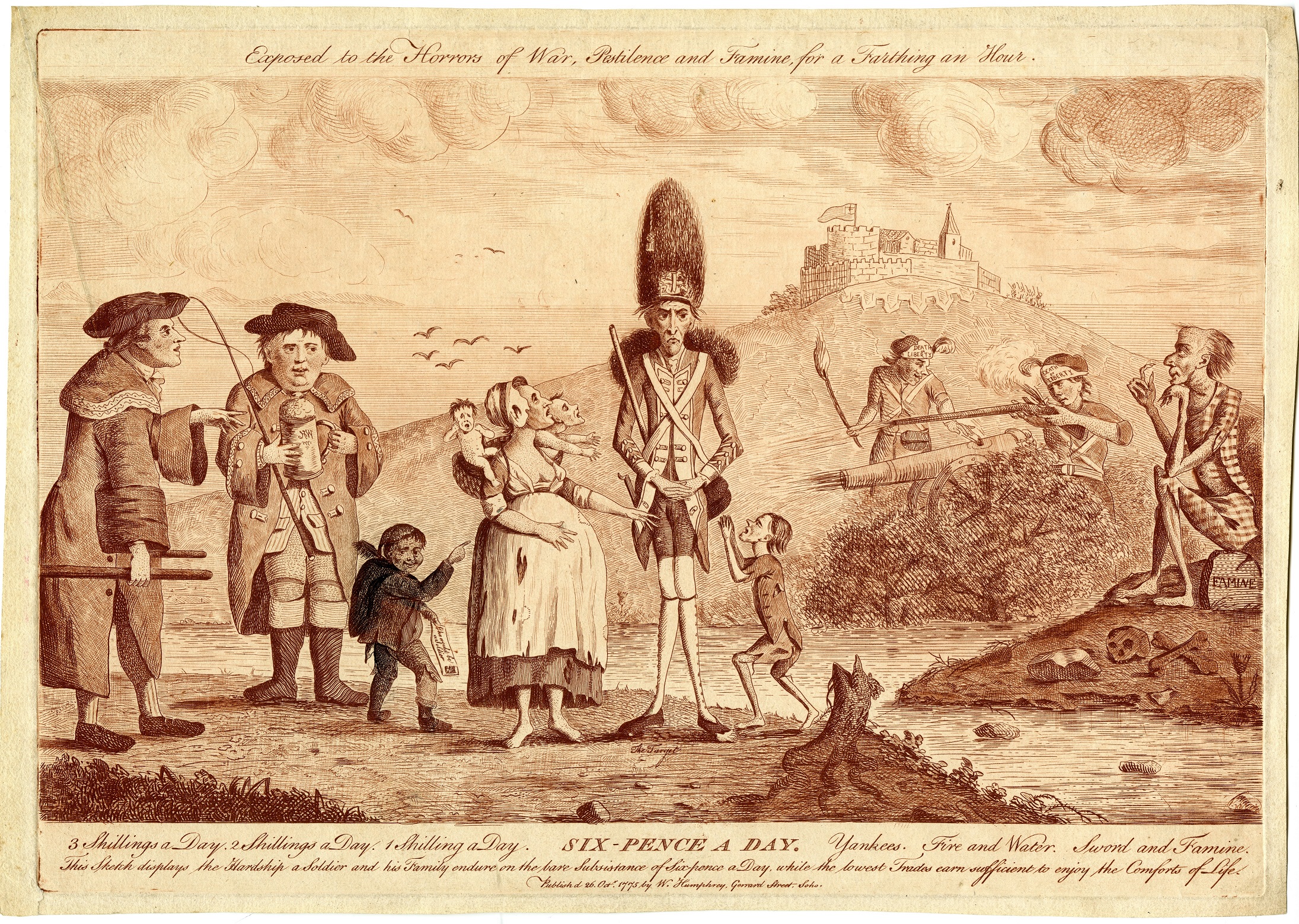
One of the First American Portrait Prints of the War
Benjamin Blyth, artist, and Joseph Hiller, engraver
The Honble Israel Putnam, Esqr, Major General of the United Forces of America
Salem, Massachusetts: Printed by Joseph Hiller, [1775]
The American Revolution Institute of the Society of the Cincinnati
This print reflects the market for images of American leaders at the beginning of the Revolutionary War and the efforts of American printmakers to supply that market with prints comparable to the engraved portraits of British officers published and sold by British printmakers. The print was based on a portrait by Benjamin Blyth of Salem, Massachusetts—a self-taught artist who worked primarily in pastels, or “crayons,” as they were commonly called. His best known works are portraits of John and Abigail Adams, which he executed in 1766 (now among the treasures of the Massachusetts Historical Society). Blyth placed a notice in the Essex Gazette for January 10-17, 1769, advertising his services: “Benjamin Blyth Begs Leave to inform the Public, that he has opened a Room for the Performance of Limning in Crayons, at the House occupied by his Father, in the great Street leading towards Marblehead, where Specimens of his Performance may be seen. All Persons who please to favour him with their Employ, may depend upon having good Likenesses, and being immediately waited on, by applying to their Humble Servant, Benjamin Blyth.”
Blyth’s portrait of Putnam, which does not seem to survive, was engraved by a young Salem silversmith, watch and clock maker named Joseph Hiller, who also engraved and sold similar prints of John Hancock and Joseph Warren (both after portraits by John Singleton Copley), Charles Lee, Richard Montgomery, Martha Washington and at least two prints of George Washington. All of them are mezzotints, a sophisticated form of intaglio engraving produced by preparing a copper plate by scoring it with a rocker, covering the plate with a crisscrossing network of tiny grooves to hold the ink, and then selectively burnishing the plate to vary the density of the grooves, creating subtle differences in the surface of the plate that produce tones of varying intensity. The most common technique used in Europe to produce printed portraits, the mezzotint takes many years of practice under the guidance of an instructor to master. Hiller apparently taught himself.
Hiller engraved another mezzotint of Putnam with a similar composition—standing and gesturing with his right hand, with the redoubt on Bunker Hill in the left background. None of the Hiller prints have been dated with any precision, but given their subjects—prominent figures in the early years of the war—they were probably engraved between 1775 and 1779. The print of Putnam depicted here was probably the first, or one of the first, in the group, and was most likely engraved in the summer or early fall of 1775. Putnam was then widely regarded as the hero of the Battle of Bunker Hill, to which this print alludes. Although Putnam lived most of his life in Connecticut, he had been born near Salem, and the Putnams were still among the town’s most prominent families. Hiller’s engravings are now among the rarest Revolutionary War prints.
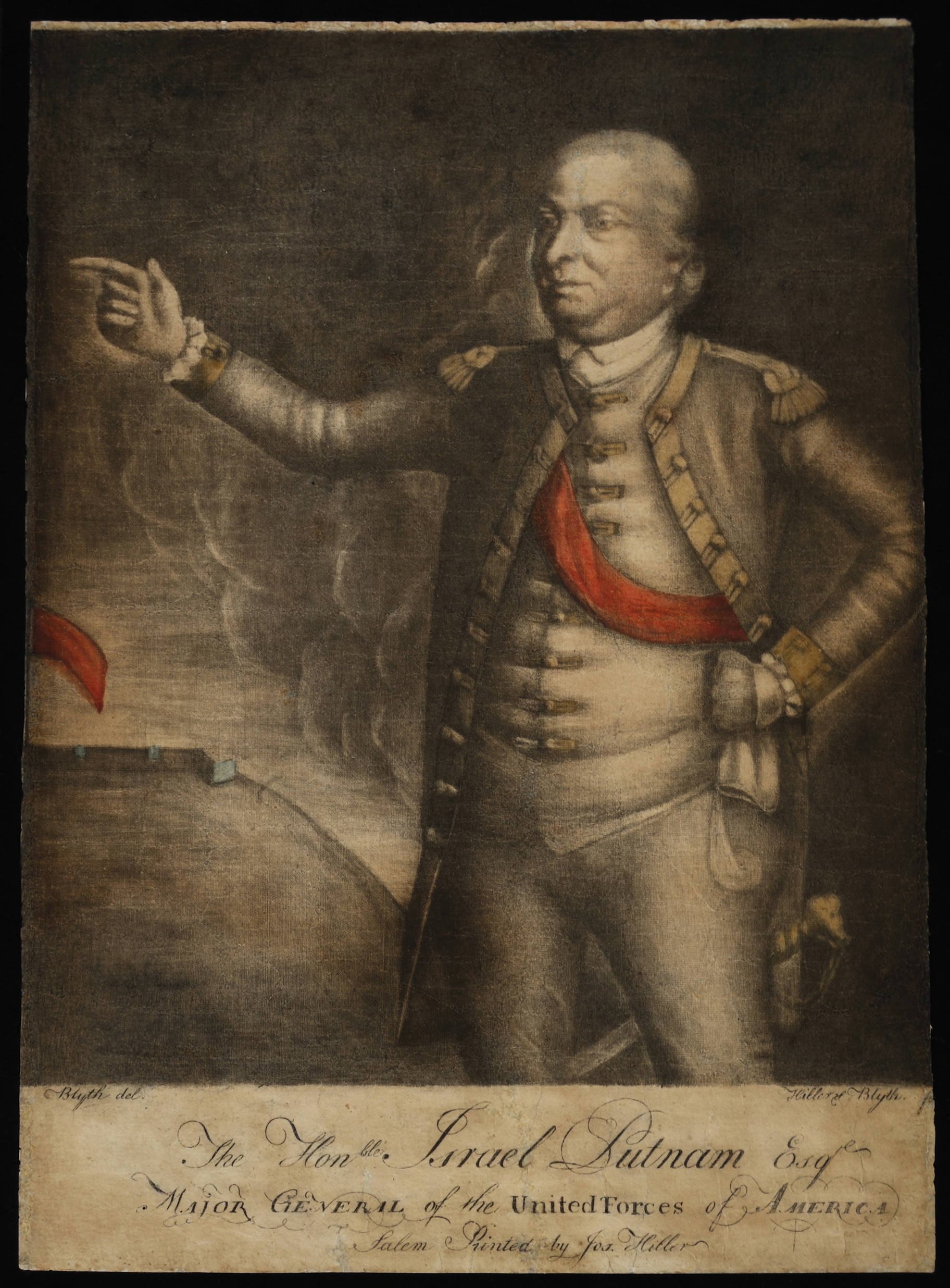
The First Authentic published portrait of George Washington
Charles Willson Peale, artist and engraver
His Excellency Gen Washington
Philadelphia: [Charles Willson Peale], 1778
The American Revolution Institute of the Society of the Cincinnati
Artists and engravers produced imaginary portraits of George Washington from the moment he was appointed commander-in-chief of the Continental Army. Charles Willson Peale used his own painted portraits—by 1778 he had painted two three-quarter-length portraits and a portrait miniature of Washington—as the basis for the first authentic published portrait of the general. It bears a closer resemblance to the portrait miniature Peale painted for Martha Washington in 1776 than to the others. Peale taught himself the engraver’s art to produce this small engraving—a mezzotint Peale embellished with etching. Peale was apparently not happy with his handiwork, and probably produced no more than about 150 impressions from the plate. Only three copies are known today—the Institute’s copy, one in the National Portrait Gallery in the United States and one in the Archivo General de Indias in Seville. The latter is undoubtedly one of four dozen copies acquired by Don Juan de Miralles, an unofficial emissary from the governor of Cuba. Miralles died suddenly on April 28, 1780, while visiting Washington at the Continental Army camp in Morristown, New Jersey, leaving his account with Peale unpaid. Other artists and engravers obtained copies of the print (and presumably paid for them) and used it as the basis for their wartime images of Washington, magnifying the influence of this print far beyond the small number who ever saw one of Peale’s impressions.
Learn more about this print in Masterpieces in Detail
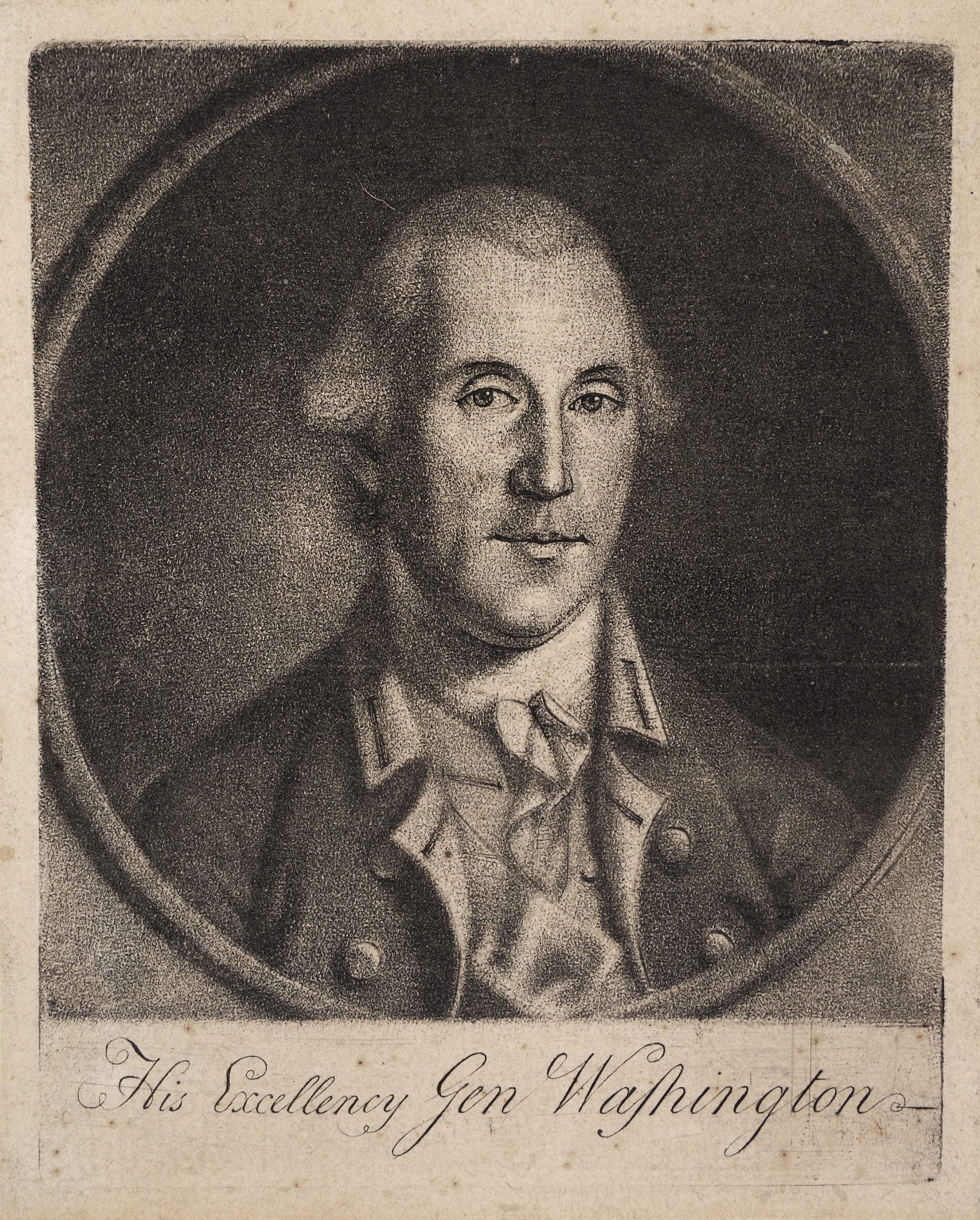
A French Allegory celebrating American Independence
Antoine Borel, artist, and Jean Charles Levasseur, engraver
L’Amerique Indépendante
Paris: chez l’Auteur, 1778
The American Revolution Institute of the Society of the Cincinnati
French printmakers dominated the European print market for most of the eighteenth century, and one look at this sophisticated mezzotint makes the reasons clear. It would be hard to imagine a print with richer or more refined details. Allegorical scenes were a favorite of French printmakers and their audiences. This one, celebrating American independence, depicts America—represented as an Indian woman—kneeling before Libertas, the goddess of liberty, identified by her rod with a pileus, or liberty cap. On the left are Mercury, god of commerce, and Ceres, goddess of agriculture. Minerva, goddess of wisdom and war, is at center with her spear poised. At right an allegory of Courage—typically represented with a club—attacks a crowned figure holding a chain, representing Britain. Neptune, with whom Britain was closely identified, lies in the water, his trident broken. Behind Courage, the allegorical figure Prudentia—a female figure representing prudence and the application of principle—stands beside the robed figure of Benjamin Franklin, who uses a ceremonial rod called a vindicta to free America from slavery.
Franklin declined the artist’s request for permission to dedicate the print to him, and when Borel renewed his request, Franklin declined again: “On reading again the Prospectus and Explanation of your Intended Print, I find the whole Merit of giving Freedom to America, continues to be ascrib’d to me, which, as I told you in our first Conversation, I could by no means approve of, as it would be unjust to the Numbers of wise and brave Men who by their Arms and Counsels have shared in the Enterprize and contributed to its Success, (as far as it has yet succeeded) at the Hazard of their Lives and Fortunes.” Franklin urged Borel to substitute a generic figure of a Roman senator for the proposed image of himself, and suggested Borel dedicate the print to the Congress of the United States. Borel dedicated the print as Frankin suggested, but made Franklin the central figure in the allegory as he had planned. The drawing was displayed at the engraver’s shop from June 20 to August 20, 1778. The prints were first offered for sale at the end of the year.
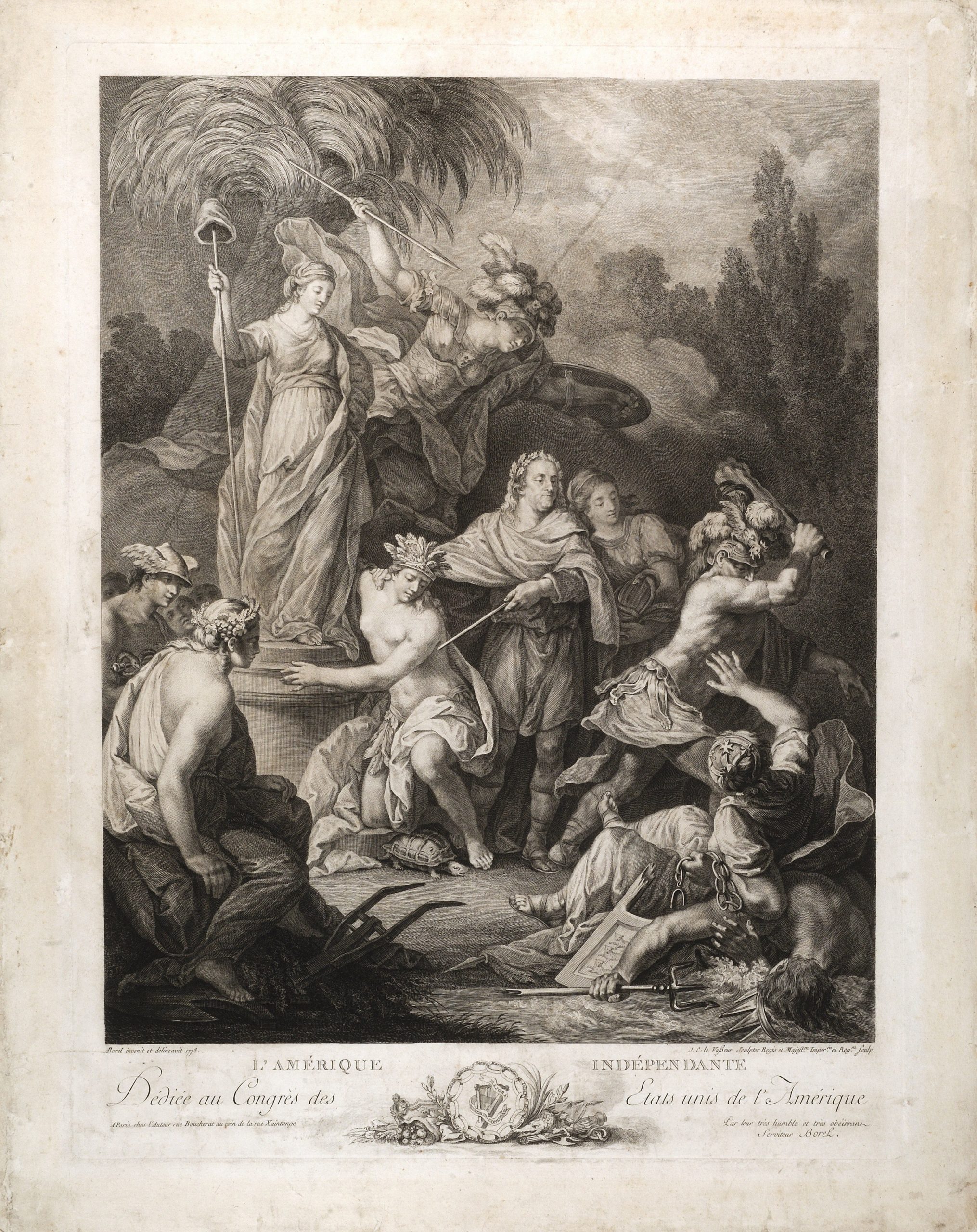
The First Authentic likeness of Washington published in Europe
Jean-Baptiste Le Paon, artist, and Noël Mire, engraver
Le Général Washington, Ne Quid Detrimenti capiat Res Publica
Paris: chez l’Auteur, 1780
Anne S.K. Brown Military Collection, Brown University
The marquis de Lafayette took a copy of Charles Willson Peale’s 1776 standing portrait of George Washington with him when he returned to France in 1779 to appeal for the king to send an army to the United States. Jean-Baptiste La Paon painted a portrait of Washington (now owned by Mount Vernon) from the Peale portrait and executed the drawing for this fine mezzotint using the same likeness of Washington. La Paon portrays Washington trampling a variety of British royal proclamations offering pardons and seeking reconciliation while defiantly holding copies of the Declaration of Independence and the Treaty of Alliance with France. On the table are military maps and a portfolio with the title “The Several States and All the Parts of the American Army,” reflecting the broad responsibilities entrusted to the commander-in-chief.
The Latin epigram in the subtitle is a short version of the Roman Senatus consultum ultimum, or final decree of the Senate, to be issued in the event of danger to the republic, authorizing the consuls to appoint a temporary dictator to lead the republic through the crisis. The decree—consules videant ne quid detrimenti capiat res publica—means “the consuls should see to it that the state receive no harm.” The epigram was plainly intended as a tribute to Washington’s conduct in deferring to Congress, even when Congress had vested him with extensive powers. “Instead of thinking myself free’d from all civil Obligations by this mark of their Confidence,” Washington wrote to Congress on January 1, 1777, “I shall constantly bear in Mind, that as the Sword was the last Resort for the preservation of our Liberties, so it ought to be the first thing laid aside, when those Liberties are firmly established.”
The legend at the bottom gives the price of the print as twelve livres, an amount equal to about eighty dollars in 2020. Dealers generally charged about twenty percent more for hand-colored prints.
View an uncolored copy of this print
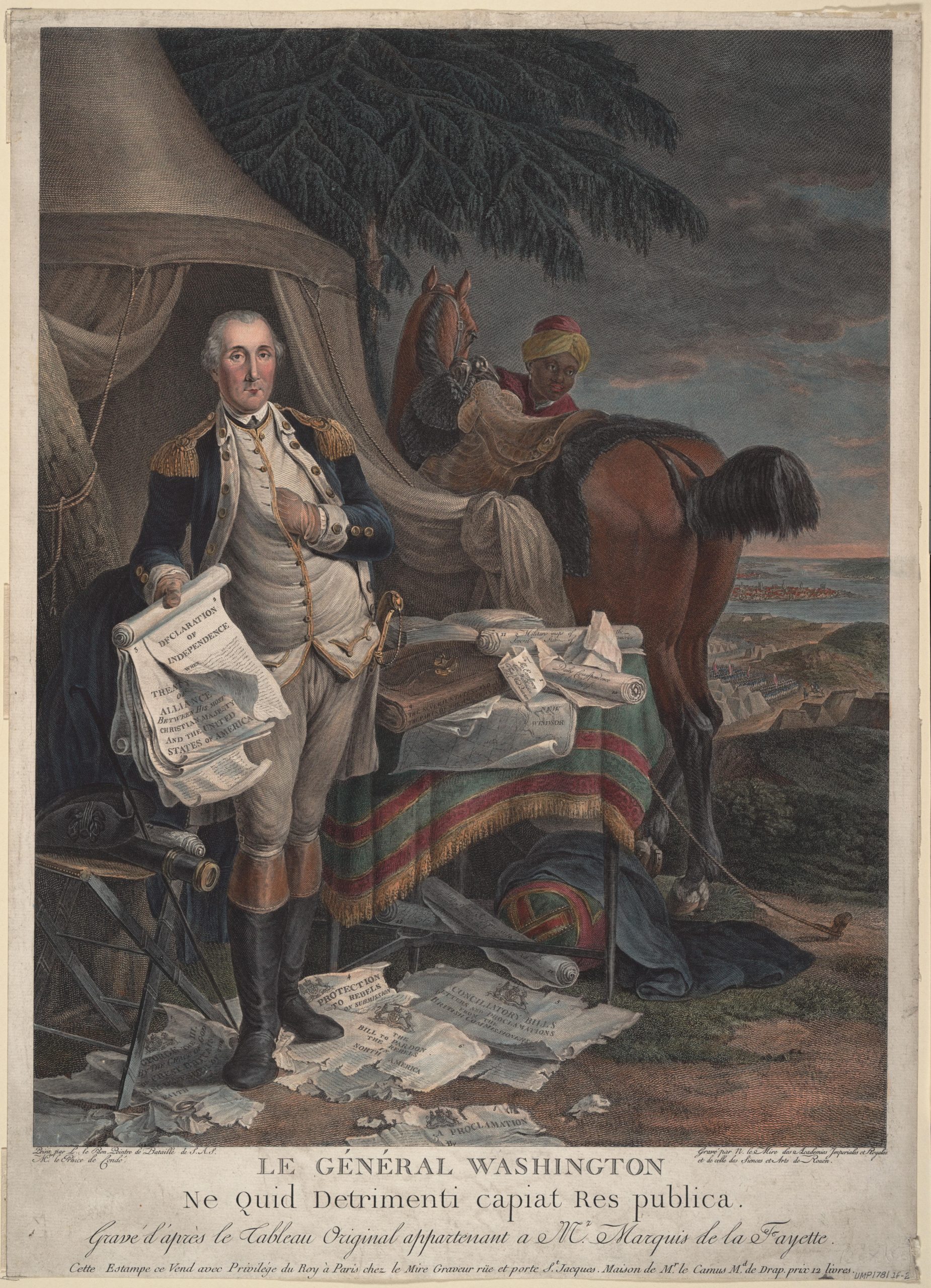
The Finest wartime print of an american warship in battle
Richard Paton, artist, and James Fittler and Daniel Lerpinière, engravers
The Memorable Engagement of Captn. Pearson of the Serapis, with Paul Jones of the Bon Homme Richard & his Squadron, Sep. 23 1779
London: John Boydell, 1781
The American Revolution Institute of the Society of the Cincinnati
Far more Britons served in the Royal Navy than in the army, and naval affairs loomed large in the popular consciousness, feeding a large and steady market in Britain for printed portraits of naval officers, depictions of ships and scenes of war at sea. Reproductive prints of painted portraits of admirals and captains sold well, as did battle scenes, often based on paintings commissioned by victorious officers or their patrons. This engraving of the savage night battle between HMS Serapis (at lower left), commanded by Richard Pearson, and Bonhomme Richard, commanded by John Paul Jones, is one of the only wartime prints to depict a warship of the Continental Navy in action—and by far the finest. The engravers, James Fittler and Daniel Lerpinière, based the print on a painting by Richard Paton, one of the most accomplished marine artists of the eighteenth century.
The image depicts the climactic phase in the Battle of Flamborough Head off the coast of Yorkshire, in which the two warships were grappled and Alliance, a frigate attached to Jones’ squadron, fired a broadside into the bow of Bonhomme Richard and the stern of Serapis, causing considerable damage to both vessels. Although Pearson surrendered shortly thereafter, he was praised for saving the valuable fleet of merchant ships he was escorting from the Baltic, which is seen sailing to safety in the right distance. The print was published and marketed by John Boydell, who was largely responsible for developing the print market in Britain. Boydell patronized talented engravers and marketed their work, while developing a brisk international trade in prints that freed artists and printmakers from the constraints of royal and aristocratic patronage.
Explore a portrait print of John Paul Jones

A British allegorY calling for Peace
Robert Edge Pine, artist, and Joseph Strutt, engraver
America
London: R.E. Pine, 1781
The American Revolution Institute of the Society of the Cincinnati
Robert Edge Pine, the son of an engraver, was born in England about 1730 and was well established as a portrait painter in Bath by the beginning of the American war. Sympathetic to the American cause, he painted a large allegorical canvas in 1778 he titled America, which he described as an allegorical scene in which “America, after having suffered the several evils of war, bewailed its unhappy cause, and lamented over the victims of its fury—her ruined towns—destroy’d commerce, &c. &c. On the appearance of Peace, is represented an extacy of gratitude to the Almighty—Heroic Virtue presents Liberty attended by Concord—Industry, followed by Plenty and her Train, form a group expressive of Population; and Ships denote Commerce.” Suffering America weeps at a cenotaph to four American heroes of the war—James Warren, James Montgomery, David Wooster and James Mercer—who had fallen in battle. Pine employed Joseph Strutt, an antiquarian and artist who worked as an engraver (Strutt engraved the illustrations for his own books) to engrave a plate of America, which Pine published himself. The print is dedicated “To Those who wish to Sheathe the Desolating Sword of War And to Restore the Blessings of Peace and Amity to a divided People.”
On August 23, 1784, George Washington’s former neighbor, George William Fairfax, wrote to Washington from Bath that he had sent him “a fine press Print, expressive of the great Oppressions and Calamities of America, also of the glorious Revolution with which it pleasd Heaven to terminate the infernal War. Heroic virtue, who heads up the train of help to weeping America was intended to represent your Excellency, and if your likeness could have been procured, it had been a fine portrait of your Person. Mr Pine the ingenious Allegorical designer and executor of that much admired peice lived very near us and did Mrs Fairfax & self the favor, to consult us oft in designing it. Poor Mr Pine is as true a ‘Son of Liberty’ as any Man can be, ever openly declared it, which with the great crime of publishing the Piece, lost him business, and made so many Enemies in this selfish Nation, that he is compelled to go to America to seek bread in his profession, tho he is certainly one of the first Artists in this Isle. Give me leave to assure you Sir, that there is not a Person in England that merits a better reception in America than the unfortunate Gentn whose only fault was his good wishes to our Country.” Pine arrived in America at the end of 1784 and supported himself painting portraits, which occupied most his time until his death in 1788. Pine exhibited America in Philadelphia and sold copies of the print. The painting was destroyed by fire in 1803.
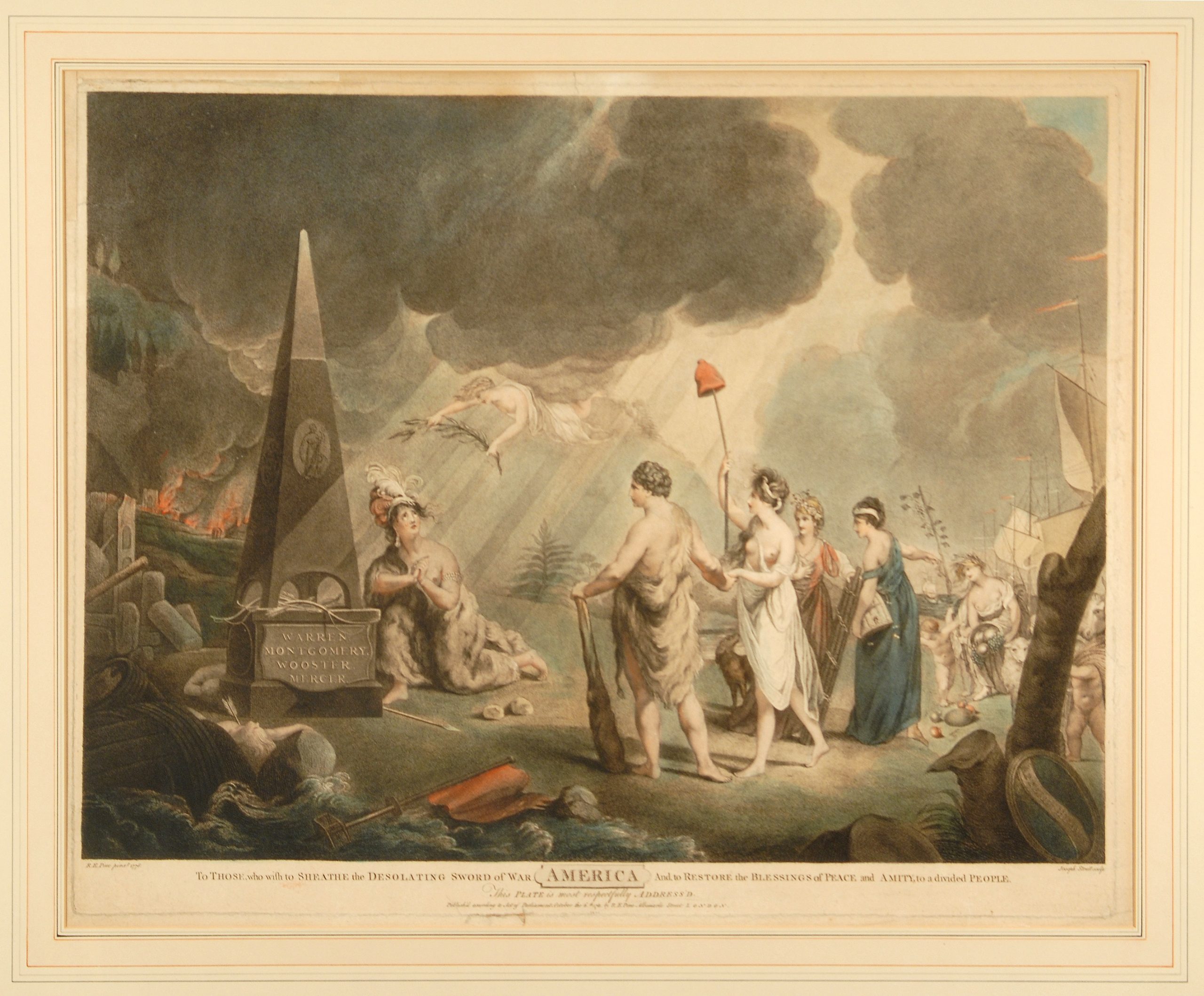
A British satire on the peace negotiations
J. Barrow, artist and engraver
The American Rattlesnake presenting Monsieur his Ally a Dish of Frogs
London: J. Barrow, November 8, 1782
The Metropolitan Museum of Art
Benjamin Franklin used an image of a snake divided into pieces as a symbol of Britain’s American colonies in the Pennsylvania Gazette in 1754, with the motto “Join, or Die.” The image played on a folk tradition that a snake cut into pieces could reunite if the pieces were placed in their proper order. If not, the snake would die. With its long, thin body, the snake was an apt visual metaphor for the thirteen colonies stretched along the Atlantic seaboard. Franklin used the image to encourage a union of the colonies against France. A decade later, during the Stamp Act crisis, the same image and motto were widely adopted to promote united action against invasive imperial regulation and increased taxation. The image reappeared to encourage colonial union in the spring of 1775.
Franklin explained the visual metaphor in the Pennsylvania Journal on December 27, 1775, writing that the rattlesnake’s “eyes excelled in brightness, that of any other animal, and that she has no eye-lids. She may therefore be esteemed an emblem of vigilance. She never begins an attack, nor, when once engaged, ever surrenders: She is therefore an emblem of magnanimity and true courage. As if anxious to prevent all pretensions of quarrelling with her, the weapons with which nature has furnished her, she conceals in the roof of her mouth, so that, to those who are unacquainted with her, she appears to be a most defenseless animal; and even when those weapons are shewn and extended for her defence, they appear weak and contemptible; but their wounds however small, are decisive and fatal. Conscious of this, she never wounds till she has generously given notice, even to her enemy, and cautioned him against the danger of treading on her.” Franklin added, “Tis curious and amazing to observe how distinct and independent of each other the rattles of this animal are, and yet how firmly they are united together, so as never to be separated but by breaking them to pieces. One of those rattles singly, is incapable of producing sound, but the ringing of thirteen together, is sufficient to alarm the boldest man living.”
British printmakers who sympathized with the American cause often depicted America as an Indian maiden, but those who regarded Americans as dangerous traitors adopted the rattlesnake as a visual metaphor for America’s venomous disloyalty, cunning and deceit. In this satirical etching published during the peace negotiations in the fall of 1782, the American rattlesnake offers his French ally a basket of freshly caught frogs. “Monsieur,” he says, “be pleas’d to accept the Frogs, I have just kill’d them in the Bogs.” The Frenchman—depicted as usual as a thin, elaborately dressed dandy—replies “I give you thanks, my good Ally, Some will make Soup, the rest a Fry.” Beneath the satirist encourages his audience:
O Britons be wise
And part these Allies,
Or drive them both into the Bogs;
I think it is fit,
They both should submit,
To Old England, or live upon Frogs.
Beneath the artist adds the note: “The Rattlesnake is a Character chosen by America.”
View an uncolored copy of this print
